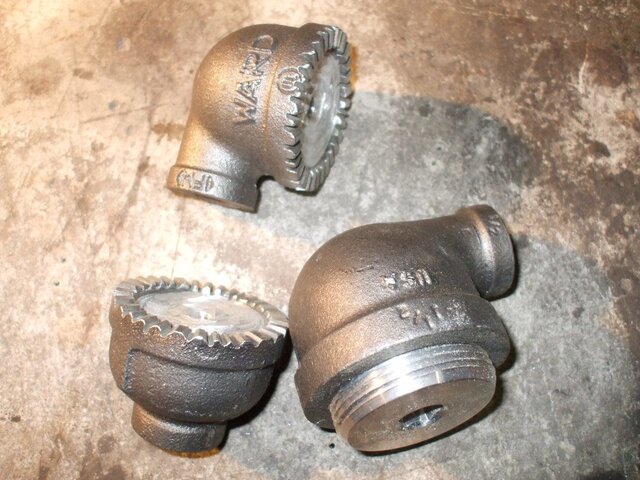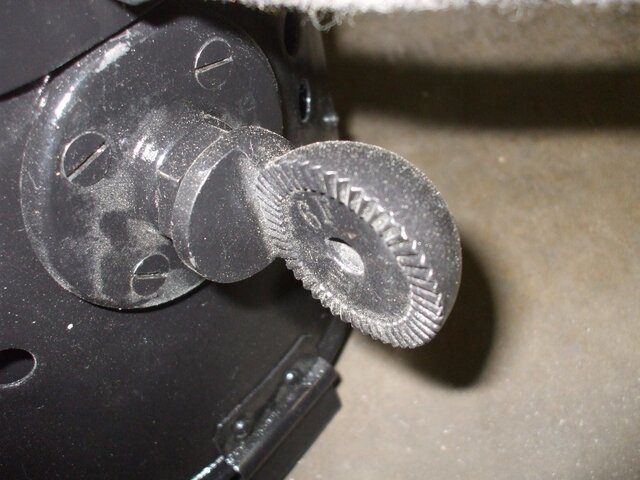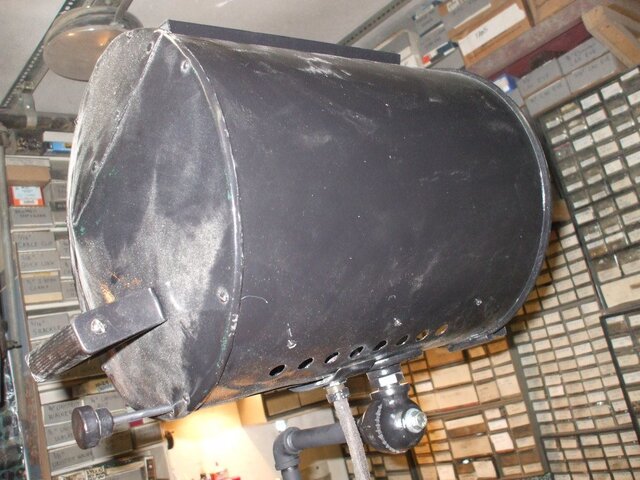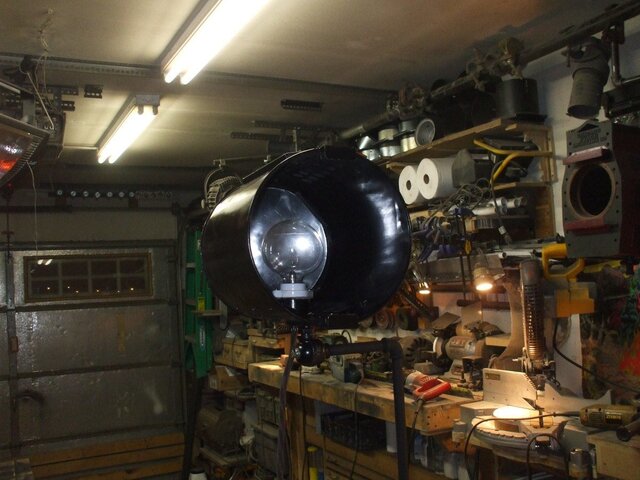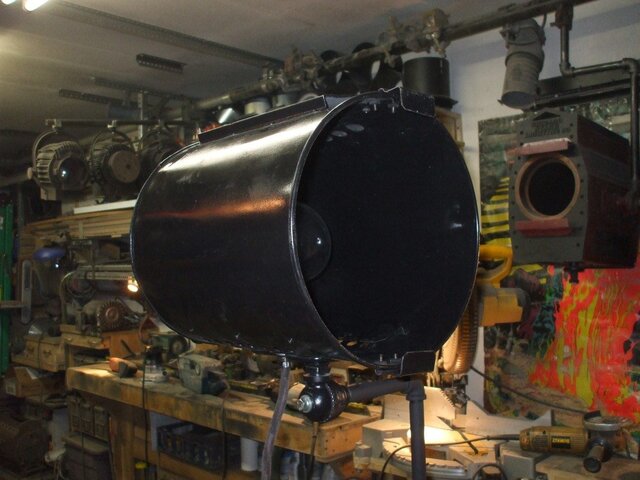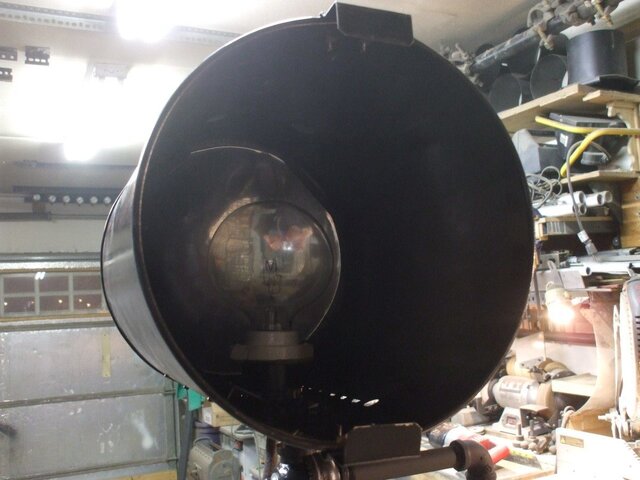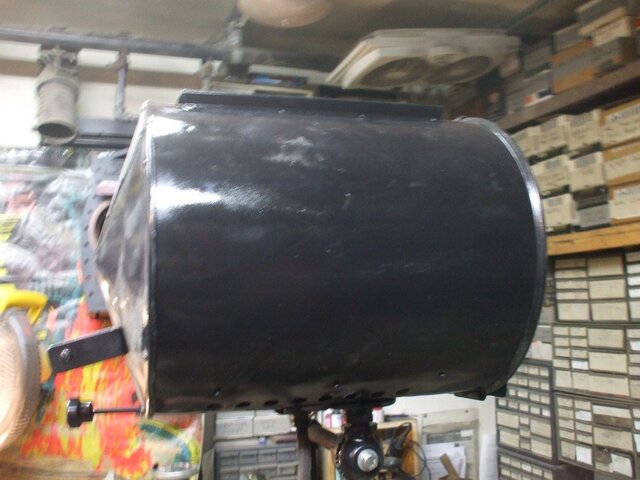Working on a 12" c.1911 floodlight fixture that’s got a lamp socket marked with the above and 1,500 Watts. Long discontinued lamp socket that was chipped/broken off in half of one of it's flanges. PC Products’ 1oz. “Fahrenheit” putty epoxy I’m trying out for use on the broken mounting fin to the lamp socket. So far shaped up well and flap sandered and drilled down well after drying time. Bit of appliance epoxy enamal spray paint applied to the socket and hard to tell which fin is the broken one.
Question is, assuming I did read X-Ray on the lamp socket, and it is say 1910-1911 for the fixture in probably the original socket for it, when did X-Ray as a term get invented? Any noting of it in or before this period? Realizing also, stage lighting history also had X-Ray products later in history noted... any relation perhaps otherwise?
Obviously, the lamp will never see the same wattage and I’ll do some padding and spring tension to the weaker socket fins instead of perhaps what broke the porcelain. Still though, a good fix seemingly so far. Don’t know how well it might work with line fixtures, but works good with this socket in repair - especially given the socket is no longer made, and in this case exposed to what one sees in viewing the open faced fixture. Epoxy and paint are necessary to present it as per how it might look if new / workable.
Wykee perhaps in what a “floodlight” fixture is, and perhaps in me having two of them, (one 4.1/2" in smaller wall mount) how rare they are to see. Good science and history of lighting in the Pre-Fresnel concept. Or is this one not a floodlight and instead an X-Ray or spot in concept? It's clearly old but see below on what must have been a very impressive glass reflector in having an effect on the focused adjustable for size beam much like what a Fresnel has, but with some beam projector properties to it assuming glass reflector.
As said, I don’t know what brand it is, the cup under this lamp socket had some writing on it, but it was spot welded to the slider plate and there was not enough letters to make anything out of it. Once re-painted, the lettering was gone in a very light stamp.
Often if a old fixture’s paint is in decent condition, I’ll rust reform and or rust reformer oil coat it sufficient in not having to sand blast and or paint stripper and grind the paint off in starting over. Try lots of products to reform pockets of rust. In this case, it was stored in a lime flaking off the brick storage room and the paint was mostly gone. In what was left, seemingly a lacquer finish over black. Far different than any other painting I have seen before, but easy enough to reproduce.
Also a note of limited lead solder reinforced bolted joints where they were not pound rivets applied. About half and half in the use - top baffle was pound rivet, bottom baffles that also mounted lamp assembly was bolted and soldered.
Chicago Cinema Equipment, Major and Chicago Stage Lighting didn’t do solder welding, Benjamin Lighting did that type of welding almost exclusively in them falling apart a hundred years later. Both bolting and welding - pound rivets aside says in all using them for places probably not any of the above brand for style.
1.5Kw lamp socket and designed about an incandescent lamp over 100w design thus it has to date post 1910 in the nitrogen lamp invention for higher wattages. That the socket is only 1.5Kw, says earlier than later when the 2Kw lamp was invented. Just finished a 5" PC type Chicago Cinema Equipment fixture with a broken lens. Was able to super glue it back together and while it looked good, once I got into buffing the lens, the dirt in the area of the crack built up into the crack area. Solid repair, but one with defined crack which Kopp Glass that probably made the lens (finally in replying) won’t make a replacement to. Nobody makes a 5" dia. lens that’s one inch thick. Gonna have to live with a cracked lens.
Important about the Chicago Cinema Equipment PC fixture is that it was designed to be a carbon arc light. Same casting for where the control levers might be for a carbon arc that just were not drilled out - instead other new holes were in use. Compared this fixture to a similar size Brenkert carbon arc spotlight, yep the CCE fixture is an incandescent fixture they made from a carbon arc type casting.
Back to the 12" Floodlight fixture in question. All the parts are ready to go in black lacquer finish to everything - photos later, missing it’s reflector. There was two of four felt lined brackets at the rear of the can still in existence. Way earlier than the aluminum Azark process - was either a steel silvered mirror reflector which would not need felt lined rolled edge 1/4" wide brackets, or more likely a glass mirrored reflector at the rear of the can. Can itself looks like a trash can, except for the great efforts they took to make a more convex top to it.
Way out of budget to get such a mirror and I am sure it will have been specacular, best I can do is a cut away Mole Richardson 10K Fresnel aluminum reflector at the rear of the fixture so as to represent what it what at about 80% and much less given the damaged one I’m replacing it with to make it work.
This no doubt was an amazing mirror in perhaps in the above socket being “X-Lite” in some way for it being a beam of light instead of flood. Again this is at least 1911 and there is no literature or knowledge about it.
Possible not just a floodlight but the original X-Beam perhaps more rare than a flood light of this size?
Lots of questions and parts to re-assemble on it. Literally on such a fixture, there is no base of what it is and or what brand it is.
P.S. I'll grind away the paint on the lamp socket cup so as to get what I can for letters not spot welded to the baffle plate. Didn't mean anything to me but perhaps might be useful later. Also the photos of what it is back to restored condition.
P.P.S, Ship you are using an epoxy that's only rated for x temperature, that much less paint not rated for it. Yep noted and the lamp no matter in me putting a 2Kw globe lamp into it for dispay purposes given it's larger than the 1Kw globe in no 1.5Kw ones in stock, or other for show use - can believe it will never be using origional lamps or wattage, and it will be dimmed way down if used. Possibly could do what was designed for, but following restoration to this extent and extent, would be antique and never used again for it's design concept - at least for long. In lamps - way too expensive to replace for any show given I have an old lamp. For prop use, better options able to do. For this open faced fixture... probably will never see any shows if I can help it. Don't own it - got work to buy it for me, but still manage it and did the work - lots of work on it.
Is it a Floodlight or perhaps the X-Lite concept? Neither I have seen before in existance.
Question is, assuming I did read X-Ray on the lamp socket, and it is say 1910-1911 for the fixture in probably the original socket for it, when did X-Ray as a term get invented? Any noting of it in or before this period? Realizing also, stage lighting history also had X-Ray products later in history noted... any relation perhaps otherwise?
Obviously, the lamp will never see the same wattage and I’ll do some padding and spring tension to the weaker socket fins instead of perhaps what broke the porcelain. Still though, a good fix seemingly so far. Don’t know how well it might work with line fixtures, but works good with this socket in repair - especially given the socket is no longer made, and in this case exposed to what one sees in viewing the open faced fixture. Epoxy and paint are necessary to present it as per how it might look if new / workable.
Wykee perhaps in what a “floodlight” fixture is, and perhaps in me having two of them, (one 4.1/2" in smaller wall mount) how rare they are to see. Good science and history of lighting in the Pre-Fresnel concept. Or is this one not a floodlight and instead an X-Ray or spot in concept? It's clearly old but see below on what must have been a very impressive glass reflector in having an effect on the focused adjustable for size beam much like what a Fresnel has, but with some beam projector properties to it assuming glass reflector.
As said, I don’t know what brand it is, the cup under this lamp socket had some writing on it, but it was spot welded to the slider plate and there was not enough letters to make anything out of it. Once re-painted, the lettering was gone in a very light stamp.
Often if a old fixture’s paint is in decent condition, I’ll rust reform and or rust reformer oil coat it sufficient in not having to sand blast and or paint stripper and grind the paint off in starting over. Try lots of products to reform pockets of rust. In this case, it was stored in a lime flaking off the brick storage room and the paint was mostly gone. In what was left, seemingly a lacquer finish over black. Far different than any other painting I have seen before, but easy enough to reproduce.
Also a note of limited lead solder reinforced bolted joints where they were not pound rivets applied. About half and half in the use - top baffle was pound rivet, bottom baffles that also mounted lamp assembly was bolted and soldered.
Chicago Cinema Equipment, Major and Chicago Stage Lighting didn’t do solder welding, Benjamin Lighting did that type of welding almost exclusively in them falling apart a hundred years later. Both bolting and welding - pound rivets aside says in all using them for places probably not any of the above brand for style.
1.5Kw lamp socket and designed about an incandescent lamp over 100w design thus it has to date post 1910 in the nitrogen lamp invention for higher wattages. That the socket is only 1.5Kw, says earlier than later when the 2Kw lamp was invented. Just finished a 5" PC type Chicago Cinema Equipment fixture with a broken lens. Was able to super glue it back together and while it looked good, once I got into buffing the lens, the dirt in the area of the crack built up into the crack area. Solid repair, but one with defined crack which Kopp Glass that probably made the lens (finally in replying) won’t make a replacement to. Nobody makes a 5" dia. lens that’s one inch thick. Gonna have to live with a cracked lens.
Important about the Chicago Cinema Equipment PC fixture is that it was designed to be a carbon arc light. Same casting for where the control levers might be for a carbon arc that just were not drilled out - instead other new holes were in use. Compared this fixture to a similar size Brenkert carbon arc spotlight, yep the CCE fixture is an incandescent fixture they made from a carbon arc type casting.
Back to the 12" Floodlight fixture in question. All the parts are ready to go in black lacquer finish to everything - photos later, missing it’s reflector. There was two of four felt lined brackets at the rear of the can still in existence. Way earlier than the aluminum Azark process - was either a steel silvered mirror reflector which would not need felt lined rolled edge 1/4" wide brackets, or more likely a glass mirrored reflector at the rear of the can. Can itself looks like a trash can, except for the great efforts they took to make a more convex top to it.
Way out of budget to get such a mirror and I am sure it will have been specacular, best I can do is a cut away Mole Richardson 10K Fresnel aluminum reflector at the rear of the fixture so as to represent what it what at about 80% and much less given the damaged one I’m replacing it with to make it work.
This no doubt was an amazing mirror in perhaps in the above socket being “X-Lite” in some way for it being a beam of light instead of flood. Again this is at least 1911 and there is no literature or knowledge about it.
Possible not just a floodlight but the original X-Beam perhaps more rare than a flood light of this size?
Lots of questions and parts to re-assemble on it. Literally on such a fixture, there is no base of what it is and or what brand it is.
P.S. I'll grind away the paint on the lamp socket cup so as to get what I can for letters not spot welded to the baffle plate. Didn't mean anything to me but perhaps might be useful later. Also the photos of what it is back to restored condition.
P.P.S, Ship you are using an epoxy that's only rated for x temperature, that much less paint not rated for it. Yep noted and the lamp no matter in me putting a 2Kw globe lamp into it for dispay purposes given it's larger than the 1Kw globe in no 1.5Kw ones in stock, or other for show use - can believe it will never be using origional lamps or wattage, and it will be dimmed way down if used. Possibly could do what was designed for, but following restoration to this extent and extent, would be antique and never used again for it's design concept - at least for long. In lamps - way too expensive to replace for any show given I have an old lamp. For prop use, better options able to do. For this open faced fixture... probably will never see any shows if I can help it. Don't own it - got work to buy it for me, but still manage it and did the work - lots of work on it.
Is it a Floodlight or perhaps the X-Lite concept? Neither I have seen before in existance.
Last edited:



